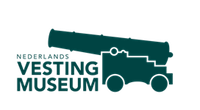Objectives
‘Raising interest in and letting people experience the history of Dutch Fortress construction, the functioning of fortresses and other durable fortifications, notably the fortress town of Naarden, as part of the New Dutch Waterline, as well as life and work therein.’
Mission
‘Introduce visitors in a pleasant and participatory way in word, image, writing and experience with the military and architectural history of Naarden Fortress and its fortifications.’
Organisation
The museum is housed in the Stichting Het Nederlands Vestingmuseum,is a recognised museum and is registered in the Museum Register.
Ethical Code Museums
The museum follows the museum standard and subscribes to the Ethical Code for Museums. For this, we use the following codes:
Governance Code Culture
The foundation uses the management model and has appointed a board charged with the daily management of the organisation. Board members fulfil their function without pay for a maximum of 2 terms of 4 years each. A retirement scheme is followed warranting the continuity of the functioning of the board. Board members do not have a financial interest and do not have additional functions that conflict with the performance of their duties as board members of the Nederlands Vestingmuseum.
Code for Diversity and Inclusion
In its approach of public, staff, volunteers and others involved in the organisation, the Dutch Fortress Museum makes no distinction as to gender, ethnicity, religion or sexual orientation. We interact on the basis of mutual respect and equality.
Fair Practice Code
The Nederlands Vestingmuseum aims at fair and transparent pay of employees and suppliers who perform work for the museum by virtue of their profession. In principle, volunteers perform their services without pay, and this also applies to members of the board. Wherever possible, voluntary work should not replace paid functions. Due to the size of the organisation, the Dutch Fortress Museum does not apply the collective agreement for museums. However, as far as it financially possible we de follow its provisions in the best way possible.
Guideline for the sale of museum objects (LAMO)
Museums manage collections with objects that are often of national historic importance and that we want to preserve for future generations. When a museum object is no longer relevant for our own collection, the museum follows the guideline for the sale of museum objects (LAMO). This way, a careful ant ethical way to go about these matters is warranted.
Insofar as it is not possible to meet this standard in certain components, we explain or elucidate this.
ANBI data
The museum is recognised as an institute pursuing public interest (ANBI). Stichting Het Nederlands Vestingmuseum receives an exploitation subsidy from the Municipality of Gooise Meren.
- Name: Stichting Het Nederlands Vestingmuseum (NVM)
- Task number NVM: 0029.12.648
Contact details
-
- Westwalstraat 6, 1411 PB Naarden
- Website: www.vestingmuseum.nl
- e-mail: info@vestingmuseum.nl
- telephone: +31 (0)35 694 54 59
- CoC number: 41192459
- VAT number: NL0029.12.648.B01
- Bank account: NL49 RABO 0343 7256 57
Management Board
-
- Chair: Oscar van den Ende
- Vice chair: Miriam van Meerten
- Secretary: Hidde van Kersen
- Treasurer: Guido van Berkel
- e-mail: bestuur@vestingmuseum.nl
- Appointment/retirement scheme of the board: hier
- Reward policy: members of the board fulfil their functions unpaid and without attendance fee. For employment conditions of paid employees, the museum follows the Museum labour conditions wherever possible.
- Policy plan: hier
- Annual Report Dutch Fortress Museum 2021 (in Dutch): hier
- Annual Accounts Dutch Fortress Museum 2021 (in Dutch): hier
The collection has been placed within a separate foundation: Stichting Vrienden van Het Nederlands Vestingmuseum. The collection is lent and entrusted to the museum by this foundation.
